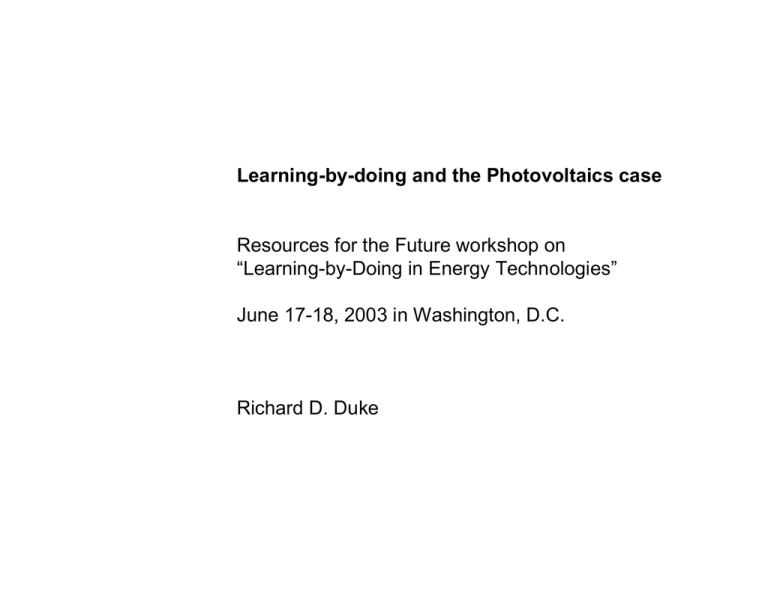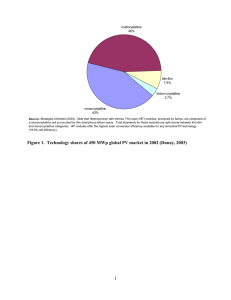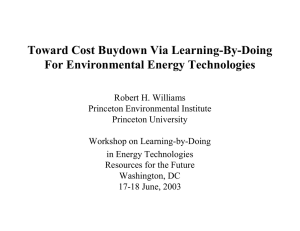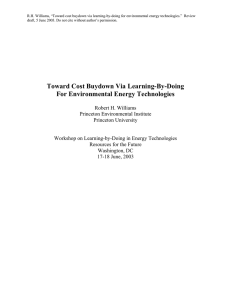Learning-by-doing and the Photovoltaics case Resources for the Future workshop on
advertisement

Learning-by-doing and the Photovoltaics case Resources for the Future workshop on “Learning-by-Doing in Energy Technologies” June 17-18, 2003 in Washington, D.C. Richard D. Duke • PV technology and markets • The PV experience curve • Benefit-cost analysis of buydowns • Buydown implementation strategies • Prioritizing scarce buydown funds • APPENDIX: Buydown economics CRYSTALLINE STILL DOMINATES THE 450 MWp PV MARKET IN 2002 multicrystalline 46% thin-film 7.9% ribbon crystalline 3.7% monocrystalline 43% Source: Strategies Unlimited (2003). Note that Heterojunction with Intrinsic Thin layer (HIT) modules, produced by Sanyo, are composed of a monocrystalline cell surrounded by thin amorphous-silicon layers. Total shipments for these modules are split evenly between thin-film and monocrystalline categories. HIT modules offer the highest solar conversion efficiency available for any terrestrial PV technology (19.5% cell efficiency). SUBSIDIZED GRID-CONNECTED MARKETS ARE BECOMING DOMINANT 500 450 Other subsidized grid plus off-grid commercial sales Subsidized residential PV in Germany Subsidized residential grid PV in Japan 400 350 MWp 300 250 200 150 100 50 0 1993 1994 1995 1996 1997 1998 1999 2000 Source: Berger (2001); Weiss and Sprau (2001); Hirschman and Takano (2003); Krampitz and Schmela (2003) 2001 2002 JAPANESE RESIDENTIAL PROGRAM HAS DRIVEN SYSTEM COSTS DOWN $35 2002 US$ per Wp $30 Installation Balance of systems Modules $25 $20 $15 $10 $0.69 $1.48 $5 $3.97 $0 1993 1994 1995 1996 1997 1998 1999 Source: Kurokawa and Ikki (2001); NEF (2001); Hirshman and Takano (2003) 2000 2001 2002 GERMAN RESIDENTIAL PV PROGRAM HAS HAD MIXED PRICE RESULTS Modules Balance of systems Installation $8 2002 US$ per Wp $7 $0.69 $6 $5 $1.43 $0.55 $0.54 $1.26 $1.30 $0.40 $1.08 $4 $3 $2 $4.75 $5.10 1999 2000 $5.63 $4.81 $1 $0 Source: Krampitz and Schmela (2003) 2001 2002 • PV technology and markets • The PV experience curve • Benefit-cost analysis of buydowns • Buydown implementation strategies • Prioritizing scarce buydown funds • APPENDIX: Buydown economics REMARKABLY CONSISTENT ALL-PV EXPERIENCE CURVE $100 Wholesale price (2002$/Wp) 1976 PR=0.80 R2 = 0.99 $10 2002 $1 0 1 10 100 cumulative PV production (GWp) Source: Johnson (2002) and Dunay (2003) 1,000 10,000 SPURIOUS MICROSTRUCTURE IN PV EXPERIENCE CURVE 100 Price (USD(2000)/Wp) Nitsch 1976-84 PR=.84 Nitsch 1984-87 PR=.53 10 Nitsch 1976-96 PR=.80 Nitsch 1987-96 PR=.79 Harmon (PR=.80) Strategies Unlimited (PR=.80) 1 0.1 1 10 100 Cumulative Sales (MW) 1000 10000 LEARNING IS THE PRIMARY DRIVER FOR THE PV EXPERIENCE CURVE • Input prices may vary, but: – Random price shocks do not impact long-term buydown economics – Buydowns will generally drive long-term input prices lower (e.g. new dedicated PV-grade silicon factories) • Scale economies are crucial, but: – Learning-by-doing is integral to the process of scaling up manufacturing facilities and markets – Available econometric evidence suggests learning effects dominate scale impacts for PV • Supply-push research and development efforts matter, but: – Learning-by-doing becomes increasingly important as products move from the lab to fullscale deployment – Private research and development is often funded in proportion to sales levels – Econometric efforts to distinguish supply-push from learning effects remain unsatisfactory (e.g. adding time as an additional independent variable does not substantially improve the model fit) • PV technology and markets • The PV experience curve • Benefit-cost analysis of buydowns • Buydown implementation strategies • Prioritizing scarce buydown funds • APPENDIX: Buydown economics THE CONVENTIONAL BREAK-EVEN METHOD HAS SERIOUS FLAWS • Does not account for sales in niche markets under the no-subsidy scenario • Does not allow estimation of the optimal sales path under buydown THE OPTIMAL PATH METHOD Faster P↓ w/ buydown • Computationally determine the optimal buydown subsidy/output path to maximize NPV Pt derived from experience curve given cumulative production at time t – Demand schedule derived from empirical estimation • Advantages – estimation of transfer subsidies – realistic modeling of sales growth under the NSS – OUTWARD SHIFTS IN PV DEMAND UNDER THE OPTIMAL PATH METHOD $5.00 break-even value of modules ($/Wp) $4.50 $4.00 $3.50 $3.00 $2.50 $2.00 X(50)=(25/(1+exp(-0.09*50+2))*P^-2 $1.50 X(10)=(25/(1+exp(-0.09*10+2))*P^-2 $1.00 $0.50 X(1)=(25/(1+exp(-0.09*2+2))*P^-2 $0.00 0 2 4 6 8 10 12 GWp per year 14 16 18 20 This figure compares the logistically shifting all-market PV demand schedule used in the optimal path method analysis with the annual OECD residential PV demand schedule (i.e. the breakeven schedule for PV demand in new U.S. homes increased by roughly a factor of 4 to account for retrofits as well as markets in Europe and Japan). In the first year of the analysis (2003) annual demand falls short of the breakeven schedule, but the two schedules overlap by year 10 after markets have matured. After 50 years, demand shifts out by another factor of four due to growth in commercial buildings and developing country markets. At the price floor of $0.50/Wp, this yields a mature sales rate of 100 GWp/y. Even in the first year, the all-market demand schedule exceeds the OECD residential PV schedule for sales levels below 1 GWp/y because it includes off-grid PV markets for which the willingness to pay is much greater than for distributed grid-connected PV. Similarly, the all-market demand schedule extends beyond 10 GWp/y (at which point the OECD residential PV demand schedule tapers off) because other markets open up at these low prices—including commercial buildings and a full range of grid-connected applications in developing countries. SNAPSHOT OF THE FIRST YEAR OF AN OPTIMAL PV BUYDOWN Year One $10 quantity demanded w/o year-one subsidy $9 quantity demanded w/ year-one subsidy $8 $7 $/Wp $6 $5 consumer surplus current price $4 $3 free riders $2 minimum possible subsidy cost failure to price discriminate TMC $1 $0 0 0.2 0.4 0.6 0.8 1 1.2 GWp/y • True marginal cost (TMC) exceeds the $0.50/Wp price floor since r > 0 • Transfer subsidies are modest 1.4 SNAPSHOT OF THE TWENTIETH YEAR OF AN OPTIMAL PV BUYDOWN Year 20 $2.0 quantity demanded w/o year-20 subsidy $1.5 quantity demanded w/ year-20 subsidy consumer surplus $/Wp current price $1.0 minimum possible subsidy cost failure to price discriminate free riders TMC $0.5 $0.0 0 5 10 15 GWp/y • TMC approaching the $0.50/Wp price floor • Transfer subsidies are potentially more severe 20 25 30 APPLYING THE OPTIMAL PATH METHOD TO GLOBAL PV MARKETS • Optimal path requires tripling $ billions per year (r=0.05) $4 $3 $2 $1 $0 0 10 20 30 current PV subsidies and sustaining support for 43 years 50 60 70 80 90 100 70 80 90 100 70 80 buydown year minimum subsidies + transfer subsidies minimum subsidies 100 90 80 GWp per year • $235 buydown benefits - $144 NSS benefits - $37 minimum possible cost $54 billion NPV (r = 0.5) 40 70 60 50 40 30 20 10 0 • PV provides 5% of OECD electricity by 2030 vs. <1% under NSS 0 10 20 30 40 50 60 buydown year buydow n • Excludes environmental benefits NSS $5 • Annual cost < 0.5% of OECD electricity expenditures $/Wp $4 $3 $2 $1 $0 0 10 20 30 40 50 60 buydown year buydown price buydown net price NSS price 90 100 SENSITIVITY OF THE NPV ESTIMATES FOR AN OPTIMAL PV BUYDOWN • Transfer subsidies valuation is controversial – NPV is $54 billion with marginal excess burden estimate of zero – NPV drops to $44 billion assuming MEB = $0.33 but no transfer subsidies – NPV drops to $27 billion assuming MEB = $0.33 and government has no ability to reduce transfer subsidies by 1) excluding free riders or using price discrimination when doling out subsidies; 2) re-optimizing the buydown to account for the MEB of transfer subsidies • Minimizing transfer subsidies is therefore crucial if MEB > 0 and/or buydown funding is constrained by politics rather than benefit-cost criteria • Progress ratio and discount rate assumptions are also crucial PV BUYDOWNS MITIGATE MULTIPLE MARKET FAILURES • Current prices do not reflect the full value of PV electricity – A $120/tC tax would increase the cost of natural gas electricity by $0.01/kWh and coal electricity by $0.03/kWh – Local air pollution externalities (primarily health impacts from particulate emissions) range from about $0.02/kWh in California (natural gas and hydro) to $0.13/kWh for coal-fired Midwestern electricity – PV electricity reduces peak demand, alleviates strain on the transmission and distribution system, and reduces price volatility • Demand-side market failures from cognitive biases/limitations – Consumers tend to under-invest in highly cost-effective energy efficiency technologies possibly due to the high cost of processing information about the available alternatives – Risk-averse homeowners/businesses may worry about individual system performance variability • Supply-side market failures from spillover of learning-by-doing – Manufacturing spillovers – System spillovers • PV technology and markets • The PV experience curve • Benefit-cost analysis of buydowns • Buydown implementation strategies • Prioritizing scarce buydown funds • APPENDIX: Buydown economics PROMISING BUYDOWN IMPLEMENTATION STRATEGIES • Loosely coordinated regional buydowns – Reduce transfer subsidies by allowing better market segmentation to reduce free riders and allow “price discrimination” when distributing subsidies – Bypass the collective action problem – Reduce the risk to manufacturers of a global market slow down – Foster learning-by-buying down • Quantity mandates (e.g. renewable portfolio standard with a PV tranche) – Reduce information burden • Fair-share of global PV buydown • Subsidy cap contains risk to obligated parties – Well-suited to long-term optimal buydown • PV technology and markets • The PV experience curve • Benefit-cost analysis of buydowns • Buydown implementation strategies • Prioritizing scarce buydown funds • APPENDIX: Buydown economics RATIONALE FOR LIMITING SUPPORT TO THE CLEAN ENERGY SECTOR • Non-learning public benefits • Slow diffusion rates • Severe system spillovers • Strong experience curve effects in some important cases • Benefits are easy to estimate based on the market price of incumbent substitutes • Energy is a commodity with thin profit margins making forwardpricing particularly difficult CRITERIA FOR SELECTING SPECIFIC CLEAN ENERGY TECHNOLOGIES • Technology picking is essential for buydowns – Buydowns are too expensive to permit a “shotgun” approach – There is relatively good information available at the deployment stage when buydowns are relevant • Governments should restrict buydowns to clean energy technologies characterized by: 1) Strong non-learning public benefits 2) A competitive (high spillover) industry 3) Strong experience curves and low expected price floors 4) Slow current sales relative to a large long-term market potential 5) The technology is at least as promising as foreseeable substitutes PV IS AT LEAST AS PROMISING AS FORESEEABLE SUBSTITUTES • Low risk from incumbent or emerging substitutes for PV – EIA predicts nearly flat U.S. residential electricity rates through 2020 – Fuel cells not a major threat • Unlikely to compete well in individual residences • Struggling to get past demonstration phase • Fuel cell vehicles plugged in at work could reduce value of commercial PV but concept unproven and residential markets are the focus of this analysis – Advanced energy efficiency would still leave most homes needing 4 kWp PV systems – Other renewables not a serious threat for the distributed residential market • The optimal path method would need to be modified to consider buydown candidates with overlapping markets (e.g. advanced biomass and wind electricity) – Must analyze both/all simultaneously – Demand for each defined as total market potential minus sales of the other – Conduct joint optimization to determine simultaneously the buydown subsidy/output path for each that maximizes total NPV • Increasing returns to adoption likely to suggest buying down one or the other • If markets only partially overlap or government wants to diversify buydown performance risk then simultaneous buydowns could be optimal • PV technology and markets • The PV experience curve • Benefit-cost analysis of buydowns • Buydown implementation strategies • Prioritizing scarce buydown funds • APPENDIX: Buydown economics THE TECHNOLOGY POLICY TRIAD MYOPIC MONOPOLIST CASE [firm’s r = infinity, social r = 0, zero spillover] Learning/experience Experience curvecurve True Marginal Cost • True marginal cost (TMC) = cost floor (since must produce initial high cost units sooner or later) • Current profit shown by the lightly-shaded box • Welfare loss equals the darkly-shaded triangle (TMC would be higher and the welfare loss would be lower if the social discount rate exceeded zero) FORWARD-PRICING MONOPOLIST CASE [firm’s r = 0, social r = 0, zero spillover] Learning/experience Experience curvecurve True Marginal Cost • Forward-pricing monopolist suffers current loss (light shading) but maximizes profit over technology lifecycle by reducing costs more quickly along its experience curve • Output closer to optimum than with myopic monopolist, but monopoly welfare losses remain ECONOMIC RATIONALE FOR BUYDOWNS [Perfect spillover/competition, r = 0] Learning/experience curve Experience curve True Marginal Cost • Perfect spillover implies: – Perfect competition is possible – Price = unit cost (including a fixed competitive profit margin) – There is no welfare loss from market power but there is a welfare loss from the failure of firm’s to forward-price • High spillover is common and buydowns can eliminate the associated welfare losses MARGINAL EXCESS BURDEN OF TAXATION (MEB) • Traditional literature [Pigou (1928); Harberger (1964); Browning (1976)] – Social costs of public spending include welfare loss from distortionary taxes – MEB estimates range as high as $1.65, i.e. projects need BCR > 2.65 (Feldstein, 1997) – Parry (1999) surveys literature and provides central estimate of MEB = $0.33 • Recent revolution – Kaplow (1996) shows MEB = 0 a better default estimate • MEB exactly zero if finance a public good with income tax adjustments that offset the benefits of the public good (e.g. progressive taxes used to finance environmental improvements that the rich value more than the poor) • MEB > 0 implies taxes and associated spending reduce regressivity and vice-versa • Must consider the combined social value of the efficiency and distributional impacts – Kaplow (1998) offers withering response to critique by Browning and Liu (1998) – Ng (2000) argues MEB < 0 in some cases, e.g. due to benefits of pollution taxes – Slemrod and Yitzhaki (2001) agrees that both distributional and distortionary impacts are important and “there is a tendency for more progressive tax schemes…to be more distorting” but points out that there are exceptions










